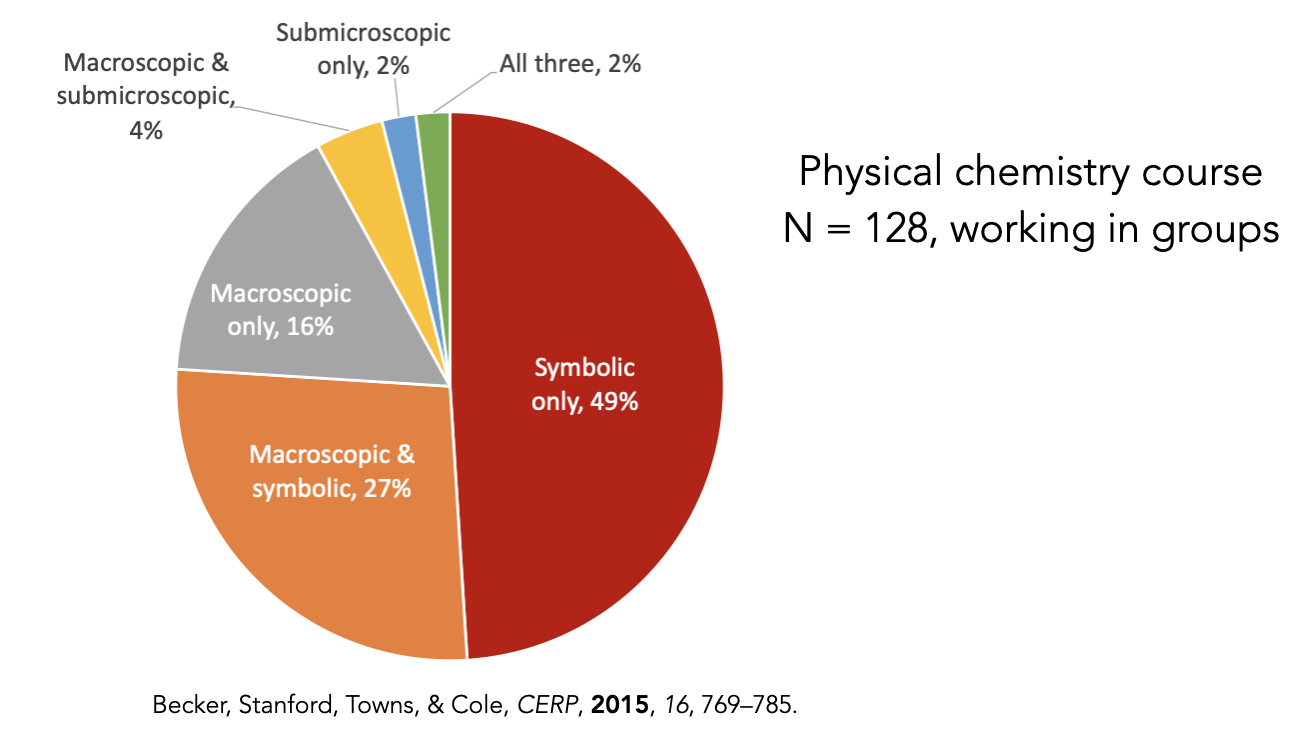Chemistry’s language
Video created by Ahmed Youssef. Finalist for uOGRADflix 2022.
We created OrgChem101 to help students learn key skills and concepts in organic chemistry. OrgChem101 is free for anyone to use, and includes three modules: Organic Nomenclature, Organic Mechanisms, and Acid-Base Reactions.
These are free, student-driven modules, interactive, available in English and French. There are videos and additional supports available for students to practice.
The many symbols and representations used in chemistry are equivalent to learning an additional language, needed to understand and connect between the macroscopic and submicroscopic levels.
Johnstone, Sch. Sci. Rev. 1982. Talanquer, J. Res. Sci. Educ. 2011. Phillip, Johnson, & Yezierski, CERP, 2014. Taskin, Bernholt, & Parchmann, CERP, 2015. Taber, in Mult. Representations in Chem Educ. 2009.
Researchers have identified many issues associated with students’ interpretations of chemistry symbols.
Students can spend a disproportionate amount of time decoding the symbols, without even getting to the intended chemistry reasoning.
Our approach
Our chemistry curriculum is designed to explicitly teach chemistry’s language, before also expecting students to use the symbolism in chemistry reasoning (1). Using real reactions, we address four learning outcomes (below). Relatively little class time is needed (approx 1/2 class) and we provide additional supports (videos, practice, free online module).
Learning outcomes for learning organic chemistry’s language.
We compared students scores on “Draw the arrows” or “Draw the products” questions with their average assessment score (midterm or exam). "Typical” ionic reactions were extremely well-done, with few reversed arrows or pentavalent atoms (common errors in other contexts). Lower scores were associated with questions bearing implicit atoms and electrons (e.g., carbene reactions) and intramolecular reaction steps (e.g., where the starting material underwent a significant conformational change from the conformation drawn on paper). N = 2504 (Draw arrows); N = 3854 (Draw products) (2).
A follow-up study using interviews revealed key themes in students thinking: they focussed on electron movement (bond-making, bond-breaking), they mapped atoms and electrons to identify what happened in the reaction, and they leveraged chemistry reasoning. They also had a surprising way of thinking about the curved arrows and reaction steps, which we are investigating further (stepwise reasoning) and they used charges as cues of reactivity, as would experts (3).
We created the Organic Reaction Mechanisms module to provide students with an online interactive resource in learning the language of organic chemistry (i.e., the curved arrow formalism). The module also includes a metacognitive components for students to explicitly identify what they know/don’t know and strategize according to their learning goals.
Watch the videos associated with the learning outcomes.
ORGANIC CHEMISTRY NOMENCLATURE
The Organic Nomenclature module is a FREE, bilingual, online, interactive learning tool designed to help students learn organic chemistry nomenclature. With this learning tool, students can draw organic molecules, name organic molecules, and identify key functional groups. There are hints to guide students along the way. Best of all, we describe the relevance of these molecules in our everyday lives! Here’s an article about the project written by Tyler Irving for the Canadian Chemical News (January 2012 issue): ACCN article.pdf and a more recent one: Organic chemistry students get online support for knowledge gap. ACCN, July/Aug 2014 issue, page 42.
Other ways to help students learn chemistry’s language and analyze reactions involves being explicit when we model drawing reaction mechanisms and problem solving, as educators, and expecting the same of students.
References
Flynn, A. B. & Ogilvie, W. W. “Mechanisms before reactions: A mechanistic approach to the organic chemistry curriculum based on patterns of electron flow” J. Chem. Educ. 2015, 92, 803–810.
Flynn, A. B. & Featherstone, R. B. "Language of mechanisms: exam analysis reveals students' strengths, strategies, and errors when using the electron-pushing formalism (curved arrows) in new reactions" Chem. Educ. Res. Pract. 2017, 18, 64.
Galloway, K. R.; Stoyanovich, C.; & Flynn, A. B. "Students’ interpretations of mechanistic language in organic chemistry before learning reactions" Chem. Educ. Res. Pract. 2017, 18, 353.
Carle, M.; Visser, R.; Flynn, A. B. “Evaluating students’ learning gains, strategies, and errors using OrgChem101’s module: organic mechanisms–mastering the arrows” Chem. Educ. Res. Pract. 2020, 21 , 582–596.
Visser, R. & Flynn, A. B. “What are students’ learning and experiences in an online learning tool designed for cognitive and metacognitive skill development?” Collected Essays on Learning and Teaching (CELT). 2018, 11, 129–140.
Webber, D. M. & Flynn, A. B. "How Are Students Solving Familiar and Unfamiliar Organic Chemistry Mechanism Questions in a New Curriculum?" J. Chem. Educ. 2018, 98, 1451–1467.












